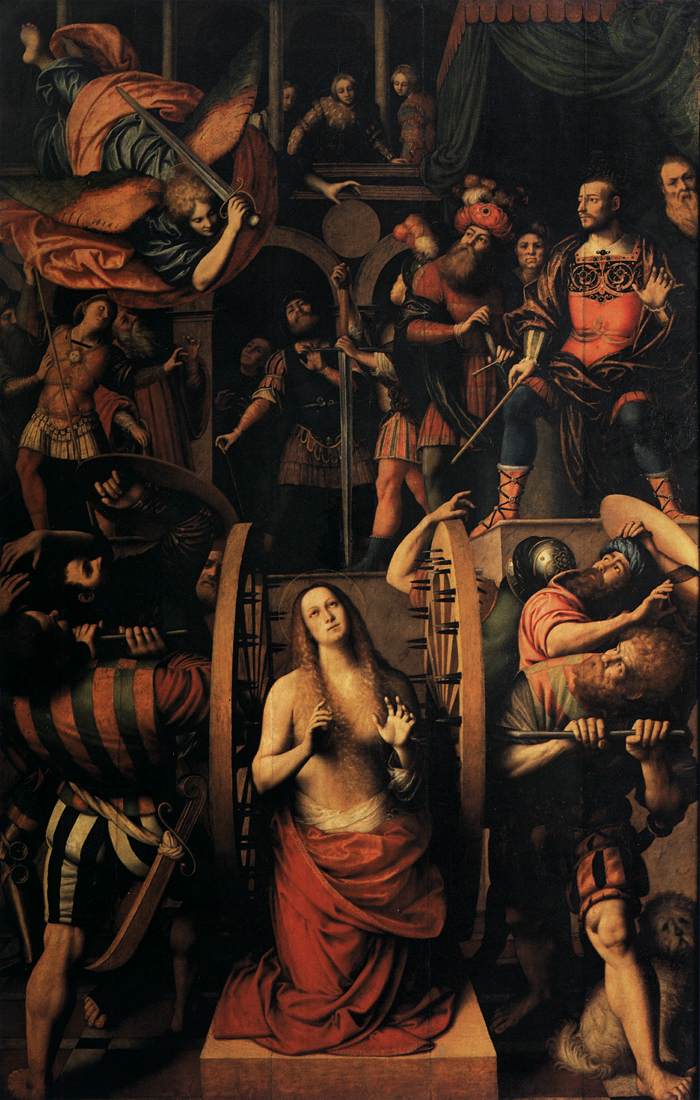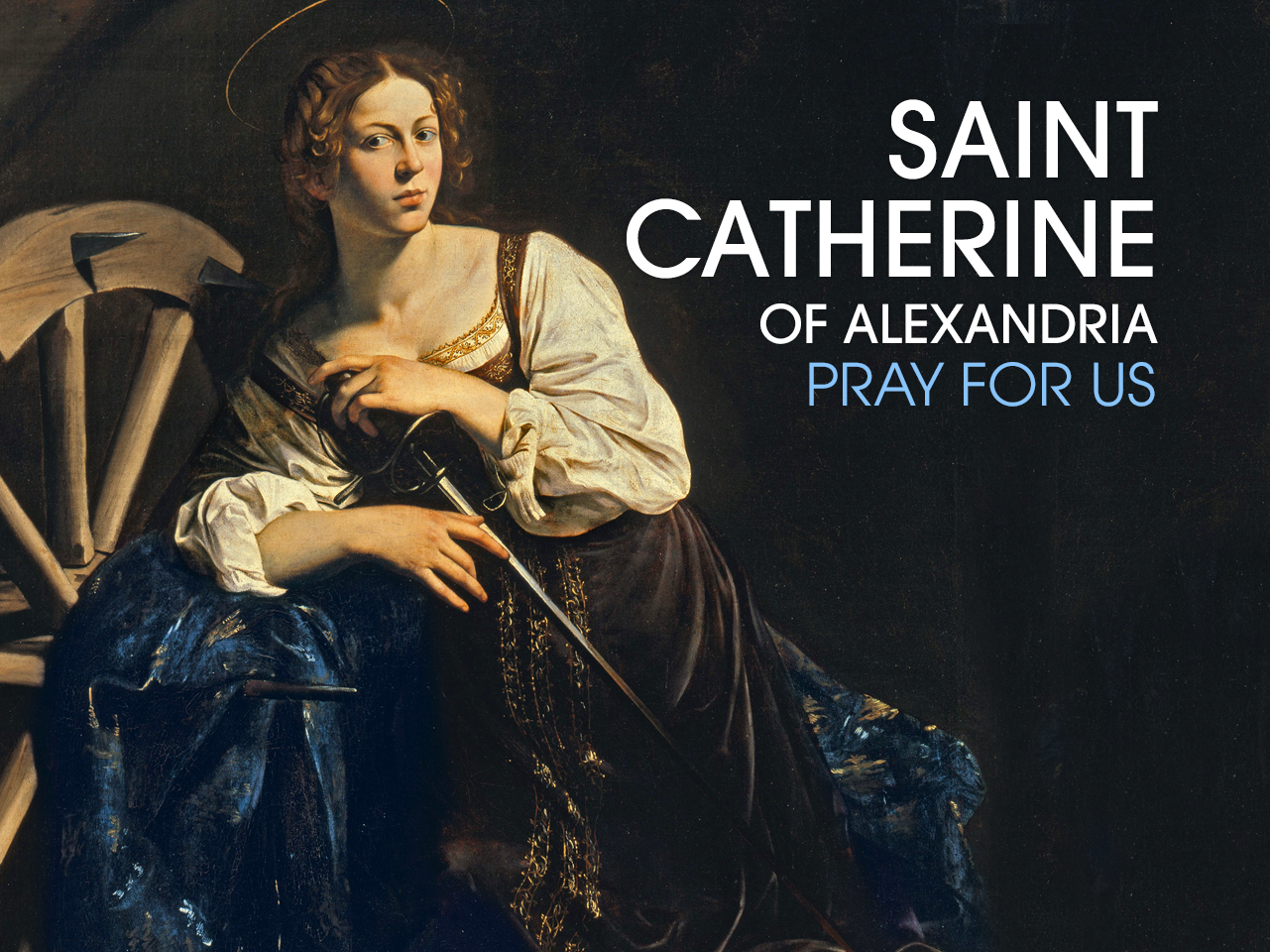
-Gaudenzio Ferrari, “The Martyrdom of St Catherine of Alexandria”, c. 1500~1550, oil on panel, 334 cm (131.5 in) x 210 cm (82.7 in).
Christians have always venerated the saints and martyrs since the inception of the Church. We have evidence of this from 1st century scratchings on the walls of the catacombs. “Vincent, you are in Christ, pray for Phoebe. Paul and Peter, pray for Victor. Sentianus, in your prayers, pray for us, for we know you are in Christ.”
This Summer (2007), Kelly and I, in honor, or mourning, if you prefer, of the ending of the HBO series “The Sopranos”, watched the entire series from beginning to end in the vacuum of Summer television programming.
In addition to being entertaining, I felt there might be therapeutic, for my wife, and practical, to me, benefits in helping my Midwestern born and raised wife understand that not all of her new husband’s volatile (relative to the Midwest) personality traits were his fault alone, but that some were certainly environmental and cultural and “from the water”, as they say, of his youth as a waif growing up in “Joisey”.
The plot of the series and the actions of its characters made perfect practical sense to me. Tony Soprano is my hero, along with Jesus Christ; a study in contrasts, I realize. I mean, really, how else or otherwise are you efficiently supposed get your point across? Negotiate? 🙂
While Kelly did gain an appreciation of her husband’s native State and its people, culture, and ways, as we watched the series, she still confessed there are many things she does not understand about me. Join the club. The mystery is the joy. To know is to love. You gotta’ problem with ‘dat?
We now regularly greet each other at home with “how you doin’?” Or, “fuggettaboutit”.
I must confess, seasons 1-3 are my favorites. I think success altered the tone of the plot after that.
In season three, episode twelve, Carmela and Meadow are touring the Met in NY, and stand before the painting “The Mystical Marriage of Saint Catherine of Alexandria” by Giuseppe (alt, Jose’ de) Ribera, 1648. Carmela begins to weep and the plot moves on.
I love the story of St Catherine of Alexandria. See…and you wondered how I was going to tie in “The Sopranos” to St Catherine of Alexandria, didn’t you? Oh, ye of little faith. 🙂
Alexandria, the historically great Egyptian city (a rival to Rome itself in nearly all aspects in the ancient world, and exceeding it in some) at the mouth of the Nile was founded by Alexander the Great. In the ancient world, Alexandria was traditionally a center of great learning, both pagan and Christian. The “Library of Alexandria”, before it burned, was sibling to one of the Seven Wonders of the Ancient World, the Lighthouse of Alexandria. Its Christian activities centered around the great church founded, according to tradition, by the Apostle Mark, with its catechetical school, the first of its kind in Christendom.
Saint Catherine lived at the end of the third century A.D. and the beginning of the fourth. Catherine was born of a patrician family of Alexandria. She was the daughter of Constus, Governor of Alexandria, Egypt. From childhood Catherine had devoted herself to study and through her reading she had learned much intellectually of Christianity. She declared to her parents that she would only enter into marriage with someone who surpassed her in reputation, wealth, beauty and wisdom.
Catherine’s mother, a secret Christian, sent her for advice to her own spiritual advisor – a monk who lived in solitude in a cave not far from the city. Having listened to Catherine, the monk said that he knew of a Youth who surpassed her in everything, such that “His beauty is more radiant than the shining of the sun, His wisdom governed all creation, His riches were spread throughout all the world—this however did not diminish but rather added to the inexpressible loftiness of his lineage.”
At this point, Catherine had not yet been baptized, but prayed all night and was granted a vision the Blessed Mother holding the infant Jesus. But the Child turned His face away from her saying that He was not able to look at her because she was ugly, of shabby lineage, beggarly and mindless like every person—not washed with the waters of holy Baptism and not sealed with the seal of the Holy Spirit.
Catherine returned again to the monk deeply saddened. The monk lovingly instructed her in the faith of Christ, admonished her to preserve her purity and integrity and to pray unceasingly; he then performed over her the mystery and sacrament of holy baptism. Again, Catherine had a vision of the Mother of God with her Child. Now the Lord looked tenderly at her and gave her a ring—a wondrous gift of the heavenly Bridegroom – a mystical marriage.
The account of Catherine’s life continues that shortly afterwards, at the age of eighteen, Catherine presented herself to the Roman Emperor Maximinus Daia who was in Alexandria celebrating a pagan feast day, but who also was carrying out a persecution of the Christians. She admonished him for his cruelty and demanded that he cease the persecutions.
Astounded and insulted at the young woman’s audacity, but lacking the training and intellectual skills necessary to debate with her, Maximinus detained her in his palace and called for fifty of his best scholars to try to trip her up in her beliefs, either to make her apostatize against Christianity or commit a heresy against the Roman pagan religion so that she could be put to death. Contrary to what Maximinus expected, she managed to convert his scholars with her eloquence and knowledge of both religion and science. Maximinus was so outraged he had all fifty of them burned alive and Catherine scourged and put in prison.
The empress, Faustina, however, heard of the extraordinary young woman and stole secretly into the prison in the company of the Roman general Porphyry. They listened to Catherine, were converted and baptized, but were both executed by Maximinus when he discovered what had happened.
The beauty of the maiden captivated the emperor. Maximinus, no longer hoping to convince the saint, tried to entice her with the promise of riches and fame by becoming his wife. Catherine gave him an angry refusal. Infuriated, Maximinus ordered Catherine to be broken on a spiked wheel. Yet at her touch, the instrument of torture was miraculously destroyed.
Seeing no alternative, Maximinus ordered her beheaded. She died in the year 305 A.D.
Her final words are recorded as: “O Jesus, good King, I await the sword for Thy sake; do Thou deign to receive my spirit, and to show mercy to those who honor my memory. Come, My chosen one, come; enter into the bridal chamber of thy Spouse. Thou hast obtained the grant of thy petition, and it shall be well with them that praise Thee.”
Her body was carried to Mount Sinai where a monastery and church were later built by the order of the Emperor Justinian. Interestingly enough, the site where Catherine’s body was found is also believed to be the site of the burning bush seen by Moses.
Eleven centuries later, when Jeanne d’Arc, a twelve year old illiterate French farm girl claimed to hear three voices telling her to drive out the English from France and bring the Dauphin to Reims for his coronation and did, Joan, at her trial for heresy after being captured by the English, claimed Catherine’s voice was one of those she heard.
In the Eastern Church, the following hymns (troparion) are used as part of the Liturgy of the Feast of St Catherine of Alexandria:
Greek usage (Tone 5)
Let us praise the all-lauded and noble bride of Christ,
the godly Catherine, the guardian of Sinai and its defense,
who is also our support and succour and our help;
for with the Holy Spirit’s sword
she hath silenced brilliantly the clever among the godless;
and being crowned as a martyr, she now doth ask great mercy for us all.
Slavic usage (Tone 4)
Thy lamb Catherine, O Jesus,
Calls out to Thee in a loud voice:
I love Thee, O my Bridegroom,
And in seeking Thee, I endure suffering.
In baptism I was crucified so that I might reign in Thee,
And died so that I might live with Thee.
Accept me as a pure sacrifice,
For I have offered myself in love.
By her prayers, save our souls, since Thou art merciful.

-Saint Catherine of Alexandria by Caravaggio, c. 1598, oil on canvas, H: 173 cm (68.1 in). W: 133 cm (52.4 in).

-The Mystical Marriage of Saint Catherine of Alexandria by Giuseppe Ribera, 1648. Catherine kisses an infant Jesus, who is held by the Virgin Mary. In the background are Saint Anne and Saint Joseph.

-ring of St Catherine given to pilgrims who visit Mount Sinai
Tradition has it that Catherine appeared three times in visions during the early days of the Order of Preachers. She was one of the Virgins (along with St. Cecilia) who accompanied the Blessed Virgin Mary when she gave Bl. Reginald the scapular. She also accompanied the Blessed Virgin in the vision in which St. Dominic saw the Virgin Mary sprinkling the brethren while they slept.
Lastly, she again accompanied the Blessed Virgin, along with St. Mary Magdalene (co-patroness of the Order of Preachers), during the transitus of the miraculous image of St. Dominic to Soriano. It might seem that not only has the Dominican Order chosen her as patroness, but you might even be able to say that she herself has chosen to watch over the Friars Preachers in a special way.
O God, you gave the law to Moses on the summit of Mount Sinai, and through your holy angels, wonderfully put in that same place the body of the blessed Catherine, your virgin and martyr; grant, we beseech you, that by her merits and intercession, we may reach that mountain which is Christ. Through Christ our Lord.

-by Philip Kosloski
“St Joan of Arc was persecuted and ridiculed for the rumors she claimed to hear. The French saint claimed to have received heavenly help from those rumors, to which she gave credit for her victories in battle.
One of the saints who often helped her in battles was Saint Catherine of Alexandria.
At the time Saint Catherine was well known throughout France, and in some places her feast day, November 25, was a public holiday. Her statues were found in almost all churches, and she was considered one of the 14 Holy Helpers.
According to the transcript of the trial of Joan of Arc, Saint Catherine often appeared with Saint Margaret, and they both helped Giovanna on the battlefield.
Giovanna, for example, believed they were responsible for the inspiration of her flag.
“She replied that the whole banner had been ordered by Our Lord, by the voices of Saint Catherine and Saint Margaret, who had told her: ‘Lift the banner in the name of the King of Heaven’. When asked about the fact that she questioned her saints and if by virtue of this she won all the battles in which she had participated and was victorious, she replied that they had told her to go ahead with courage, and that God would help her ”.
Victories
The Saints revealed to her the battles she would win.
“The related Giovanna claims to have had for five years, and still have, visions and apparitions of St. Michael, St. Catherine and St. Margaret, and that they had revealed to her in particular that she should have lifted the siege of Orleans and crowned Charles , whom he calls king, and expel all opponents of the kingdom of France ”.
Saint Catherine revealed to Joan of Arc how she would be wounded and captured by the English.
“She said that when she learned that the English would come and take her away she was very brave, and even if their voices prevented her from jumping from the tower, in the end, out of fear of the English, she would jump, trusting in God and Madonna, but at that moment she would have been hurt. And when she made that leap, the voice of Saint Catherine told her to keep the good disposition [because she would recover] and that the people in Compiègne would have help ”.
In the course of her trial, Saint Catherine would comfort Joan of Arc and encourage her to persevere to the end. Catherine’s presence and heavenly help were essential to Joan’s determination, willing to face anything for the greater glory of God.
Love,
Matthew


